| "Sunlit" Portrait:
(This is my new "Outdoor" Portrait test - read more about it here.)
High resolution and good detail, though slightly warm color. Contrast is high, with limited detail in the highlights and shadows.
- Exposure compensation: +0.7 EV, about average.
- Contrast/Tone: High, some highlight detail lost, even with fairly dark midtones.
- White Balance: Auto and Daylight both slightly warm.
- Color accuracy: Aside from the warm cast, not too bad. Blues are a bit dark, as are the greens and yellows.
- Skin tones: A little warm, but pretty good.
- Resolution/sharpness: Good, where the camera is actually focused: It seems to have focused on the flower bouquet, rather than on Marti's face. As a result, the bouquet is sharp, but Marti's hair and face are a little soft.
- Shadow detail: Pretty good, pretty low noise.
To view the entire exposure series from zero to +1.3 EV, see files W5OUTAP0.HTM through W5OUTAP4.HTM on the thumbnail index page.
Contrast Series:
The Sony DSC-W7's contrast adjustment does work to hold down the contrast here, and color saturation on bright colors is relatively unaffected. There's an odd effect on Marti's skin tones though, with her skin going almost gray in places. Hence, perhaps OK for landscape shots, but I don't recommend the low-contrast setting for use with human subjects. A shame, the camera does really need this control to handle harsh lighting like this.
|
|
Closer Portrait: 
Higher resolution and stronger detail, but again, high contrast.
- Exposure compensation: +0.7 EV, about average (and the same as the wider shot).
- Exposure/Tone: Contrast very high, with stark highlights and shadows.
- Detail: Stronger detail, though details still slightly soft overall.
- Distortion: Good, 3x zoom lens helps prevent distortion close-in like this, though some is noticeable.
To view the entire exposure series from zero to +1.0 EV, see files W5OUTFACAP0.HTM through W5OUTFACAP3.HTM on the thumbnail index page.
|
|
Indoor Portrait, Flash:
Normal Flash
High Intensity
|
 |
Slow-Sync Flash
High Intensity
|
 |
Underexposed in both Normal and Slow-Sync flash modes, even with increased intensity. Warm color cast with Slow-Sync.
- Exposure: Dim even with High intensity setting, though brighter than the default exposure. Slow-Sync mode brighter, but stronger warm cast.
- Flash balance with room lighting?: Good, in that the highlights from the flash aren't blue-colored.
- Color: Red skin tones, dark colors in bouquet
Normal Flash Series:
Slow-Sync Flash Series:
|
|
Indoor Portrait, No Flash:
|
Auto White Balance
|
 |
|
Incandescent White Balance
|
 |
Slightly warm color with the Incandescent white balance, and a bit more exposure compensation than average.
- Exposure: +1.3 EV adjustment needed, slightly higher than average. Default exposure quite dim.
- White Balance: Incandescent good (though a hint warm), Auto poor, very warm.
- Color: Slightly warm overall, flowers dark, though red flowers are quite bright.
ISO Series:
The Sony DSC-W5 does a good job of holding image noise in check as the ISO (light sensitivity) is increased, but it does so by trading away subject detail in areas of subtle contrast. This means that shots at ISO 400 are rather soft-looking (although probably acceptable to many users) when printed at 8x10 inches, but look fine at sizes of 5x7 and below.
|
|
House Shot:
|
Auto White Balance
|
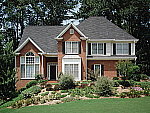 |
|
Daylight White Balance
|
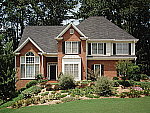 |
Pretty good color with the Auto white balance, with high resolution and good detail. Some blurring in the corners though.
- Sharpness/Detail: Pretty good overall.
- Sharpness in Corners: Some falloff, about average.
- Color: Auto white balance best, Daylight setting a little warm.
- Detail lost to anti-noise processing?: Some in the shaded areas of the brick pattern and the grass.
|
|
Far-Field Test 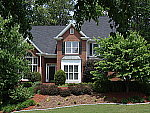
High resolution and strong detail, with a pretty good dynamic range.
This image is shot at infinity to test far-field lens performance, and to present a near-infinite range of detail to the camera. NOTE that this image cannot be directly compared to the other "house" shot, which is a poster, shot in the studio.
- Sharpness/Detail: Good, strong detail in the foliage and house.
- Sharpness in Corners: Very good, much better than average.
- Color: Slightly dark, but pretty accurate.
- Dynamic Range: Pretty good, good detail in highlights, a bit less in shadows.
- Detail lost to anti-noise processing?: Very little, only a slight amount in shingles.
Resolution Series:
ISO Series:
Sharpness Series:
A good range of sharpness adjustment. Low setting takes unsharp masking in Photoshop(tm) very well, High is a little coarse-looking, but would be good for inkjet prints at small print sizes (5x7 inches or below).
Contrast Series:
The contrast adjustment works better here than in the Sunlit Portrait test above, since the odd saturation changes aren't apparent in a complex subject like this.
Saturation Series:
A good range of saturation adjustment, little impact on contrast.
Color Series:
|
|
Lens Zoom Range
A typical 3x zoom range.
The DSC-W5's focal length range of 38-114mm equivalents is fairly typical of most point & shoot digital cameras. (Just slightly less wide-angle than the 35-105mm range that's most common.) It corresponds to a moderate wide angle to a modest telephoto.
|
|
Musicians Poster
|
Auto White Balance
|
 |
|
Daylight White Balance
|
 |
Pretty good color, though dark, and good resolution and detail.
- White Balance: Auto setting best overall, Daylight setting a bit warm.
- Color: Good skin tones, but blue robe and background are a little purple.
- Sharpness/Detail: A lot of fine detail and high resolution, with good sharpness. (Pushing the limits of the poster though.)
|
|
Macro Shot
|
Standard Macro Shot
|
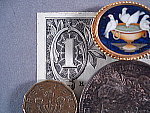 |
|
Macro with Flash
|
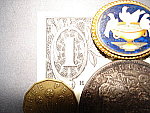 |
A small macro area with pretty good (though slightly soft) detail. Flash has trouble up close though.
- Minimum Macro Area: 2.31 x 1.74 inches (59 x 44 millimeters), about average.
- Softness in corners?: A fair amount, extending far into the frame. (Most cameras get fairly soft corners in macro mode, the W5's softness extends a bit further into the frame than I'd like though.)
- Flash performance in macro mode?: Flash doesn't throttle down enough for macro area, overexposes the shot.
|
|
"Davebox" Test Target
|
Auto White Balance
|
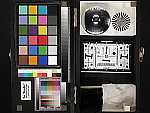 |
|
Daylight White Balance
|
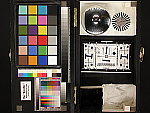 |
Good overall exposure, slightly warm color balance, good color accuracy.
- White balance: Auto setting best though slightly yellow, Daylight setting warmer yet.
- Color Accuracy: A slight warm color cast overall, but most colors are quite accurate. The bright red swatch is quite oversaturated though, green is slightly oversaturated, and yellow is undersaturated. Bottom line though, better than average color accuracy.
- Shadow detail and noise: Good detail in the briquettes, low noise.
The images series below duplicate examples of various camera controls we've already covered above. I include them here though, for our more analytically-minded readers, who'd like to see the effect of various camera controls with a well-known target like the MacBeth Color Checker (tm).
ISO Series:
Contrast Series:
Saturation Series:
Color Series:
|
|
Low-Light Tests
Good low-light performance, with moderately low noise and good color. Autofocus system works to about 1/4 foot-candle, fine for average city night scenes.
- Exposure limit: 1/16 foot-candle at all three ISO settings. (About 1/16 as bright as typical city street lighting at night.)
- Autofocus Limit: To 1/4 foot-candle with standard autofocus, all the way to 1/16 foot-candle with AF assist.
- White Balance: Slightly pink in some shots, but better than average overall.
- Noise Levels: Higher at ISO 400, but good at the lower ISOs.
- Detail loss to anti-noise processing?: A fair bit, particularly at higher ISOs, but the results are a little hard to see in these shots.
- General Notes: The Sony DSC-W5 is an excellent low-light shooter, able to deliver well-exposed shots to the limit of our test (1/16 foot-candle, about 1/16 the brightness of typical city night scenes), at any ISO setting. Its autofocus system works down to about 1/4 foot-candle with the AF assist light turned off, and in total darkness on nearby objects with the AF assist enabled. Noise levels are quite low, although some subtle subject detail is traded away, particularly at the highest ISO setting. All in all though, a good choice for after-dark available-light photography. (Note though, that its flash tends to underexpose a fair bit, see the comments below about that.)
(Note: If you'd like to use a light meter to check light levels for subjects you might be interested in shooting, a light level of one foot-candle corresponds to a normal exposure of two seconds at f/2.8 and ISO 100.)
| |
1 fc
11 lux |
1/2 fc
5.5 lux |
1/4 fc
2.7 lux |
1/8 fc
1.3 lux |
1/16 fc
0.67 lux |
ISO
100 |

2 sec
f2.8 |

4 sec
f2.8 |

10 sec
f2.8 |

15 sec
f2.8 |

25 sec
f2.8 |
ISO
200 |

1 sec
f2.8 |

2 sec
f2.8 |

5 sec
f2.8 |

8 sec
f2.8 |

13 sec
f2.8 |
ISO
400 |

1/2 sec
f2.8 |

1 sec
f2.8 |

2.5 sec
f2.8 |

4 sec
f2.8 |

7 sec
f2.8 |
|
|
Flash Range Test
Slightly underexposed at eight and nine feet, then decreasing intensity all the way to 14 feet.
- Flash range at telephoto lens setting: Nine feet.
| 8 ft |
9 ft |
10 ft |
11 ft |
12 ft |
13 ft |
14 ft |

1/50 sec
f5.2
ISO 100 |

1/50 sec
f5.2
ISO 100 |

1/50 sec
f5.2
ISO 100 |

1/50 sec
f5.2
ISO 100 |

1/50 sec
f5.2
ISO 100 |

1/50 sec
f5.2
ISO 100 |

1/50 sec
f5.2
ISO 100 |
|
|
ISO-12233 (WG-18) Resolution Test 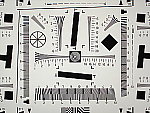
Good resolution, 1,350 lines of "strong detail." Higher than average barrel distortion at wide angle, but very low pincushion at telephoto. Low chromatic aberration, particularly at telephoto, soft corners at wide angle, less so at telephoto.
- Resolution: 1,350 lines both vertically and horizontally.
- Artifacts begin at: ~1,100 lines.
- Extinction point: ~1,700 lines.
- Barrel/Pincushion distortion: 0.9 percent barrel at wide angle, 0.08 percent at telephoto.
- Chromatic Aberration: Moderately high at wide angle, very low at telephoto.
- Corner Sharpness: A moderate amount at wide angle, though less at telephoto.
Resolution Series, medium focal length
Resolution Test, Zoom Series
2,592 x 1,944
(Fine,
Wide Angle) |
W5RESW
|
2,592 x 1,944
(Fine,
Telephoto) |
W5REST
|
Sharpness Series:
|
Viewfinder Accuracy/Flash Uniformity
An accurate LCD monitor, but a tight optical viewfinder. A lot of flash falloff at wide angle, but less at telephoto.
- Optical Viewfinder Accuracy: A little tight, 85 percent at wide angle, and 82 percent at telephoto.
- LCD Viewfinder Accuracy: Just a little loose, showing slightly more than what's in the final frame, though still very close to 100 percent.
- Flash Uniformity: A lot of falloff at wide angle, much less at telephoto.
|

Follow Imaging Resource: